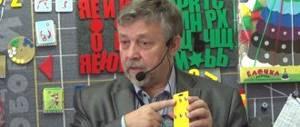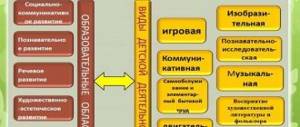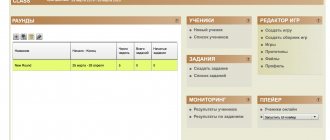Children's development largely occurs through play. Children 2-3 years old, who are just joining the ranks of preschoolers, begin to spend a lot of time in a group of peers, gaining new knowledge. Do-it-yourself didactic games are especially valuable in preschool educational institutions. This is the warmth and care of a master who puts his soul into each child, as well as the opportunity to give children sensory development and first skills in mathematics and logic. We present to your attention a master class on creating a bright didactic game with a mathematical bias for the younger group of preschool educational institutions, which older preschoolers will also enjoy playing. The process is accompanied by pictures, so it will be easier for you to create.
Do-it-yourself didactic games - mathematics can be interesting
To make a didactic game with your own hands, you first need to prepare and, which is very important, calculate the material. Let's call it "Harvest" - the guys will be able to put three types of fruit on three different trees, and then collect them in plates, leaving the leaves. When the kids grow up, they will be able to play this didactic game with a different interest: count which fruits they have collected more or less, and distribute equally to all children.
For preschoolers in kindergarten, it is important not only to play, but also to learn new knowledge. In the didactic game “Let's Harvest,” preschoolers come to the idea of what kind of fruits grow on trees, what exactly these are fruits. They can tell what fruits taste like in each individual case, share their opinions about them, and this is the development of speech. Let's get started!
How to use the game "Didactic Box"
The game can be used to introduce children to colors, seasons, geometric shapes, develop fine motor skills (exercises using clothespins), and develop the child’s speech.
Options for tasks with the game:
- choose a pair (attach red clothespins to the red sector, yellow ones to the yellow one, and so on in accordance with the color of the sectors),
- name the color of the animals - game with a box lid (speech grammar game for mastering the agreement of adjectives and nouns: gray bunny, gray mouse, gray cats). We place the animal figurine on the side magnetic panel of the lid in the corresponding color sector and name the animal and its color,
- seasons (arrange pictures with signs of seasons into sectors and explain your choice - why the child thinks that the picture shows spring, and not summer or autumn),
- development of fine motor skills: a) attaching clothespins of different colors in accordance with the color of the sectors, or b) clothespins with figures on the side of the box. (For example, in the game “find your house”. If the bow of a toy is blue, then its house is blue. And the animal figurine needs to be attached to the blue sector. If it is red, then it is red, etc.),
— classification. The task is to arrange geometric figures of different shapes, sizes, thicknesses by color into sectors in a box (the child needs to highlight the leading feature - color, without paying attention to the different thicknesses of the figures and their size and shape)
- collect the months of the year (we name the months of each season, if the child correctly named the month, then he attaches a clothespin to the corresponding sector).
- find neighbors (name the neighbors of the month - for example, the neighbors of January are December and February).
The box can also be used as a little house for director's games with children.
We wish you interesting games!
Creative materials
Anything you have can be useful. In total, you need to make three trees, several fruits of three types (for us these will be plums, pears and apples), three plates for them, and also, if desired, leaves. In order for children to develop their sensory skills as best as possible, it is worth making parts from different materials. It could be:
- Felt. Do-it-yourself didactic games made from this material are considered one of the best, since it is wear-resistant, has many beautiful colors and is easy to create.
- Rubber (or rubberized colored paper).
- Cardboard (thin and thick).
- Self-adhesive paper.
- A box or casket in which you can put parts of a didactic game.
- Of course, for the DIY process you will need scissors, a needle, colored threads (preferably floss), and a ruler. We also used green gouache to paint the back of the trees.
DIY didactic games - master class
The first step is to make the trees. But in order for them to fit into the future box, it is worth measuring its width and length - the values must either correspond to or be larger than the model of the tree. In our case, this is approximately A4 format (we used a cereal box). We draw the future tree on paper and cut it out.
You can draw directly on cardboard if you are not afraid of making a mistake with the size. We cut out trees from thick cardboard and cover them with self-adhesive paper. You can glue felt parts if there is enough green in stock.
The next step in creating educational material with your own hands for our beloved kids is fruit. We also prepare patterns for them from plain white paper.
One pattern is made for each fruit - we apply it to thin cardboard and outline it. You need to make as many cardboard blanks for the didactic game as there are fruits. We have 7 plums, 6 apples and 5 pears. Attention! You need to cut out the layouts from thin cardboard with an indentation of 3-4 mm inward, so that later it will be more convenient to place them between two layers of felt.
Using patterns from plain paper, you need to make felt blanks for fruit. To do this, the optimal colors are selected and twice as many fruits are cut out as we already have cardboard blanks.
It is important to choose the right thread color for the parts. If you don’t have floss of suitable colors, then you can sheathe all the fruits in one color - for example, white.
Now we sew the halves together, inserting the center one cardboard blank at a time. The fruits for the didactic game are ready!
So that preschool children can collect crops from trees, they need to make plates or baskets. Similarly, we cut out patterns for 3 plates.
It is better to sew the details of the plates in black or another contrasting color to imitate the recess in them.
To make the details of the didactic game different, you can make leaves for the trees. You can make them yourself from the same felt, or you can cut them out of cardboard or rubberized paper, as in our game. You can also decorate the game with bright flowers by making an impromptu lawn around the trees. A big plus is additional accessories like birds, bunnies or other animals that will help the children collect the ripe harvest. Our DIY didactic game is ready!
All that remains is to transform the box for the didactic game. To do this, we will cover the existing box with self-adhesive paper, preferably white. We print out the name of the game on a printer and stick it with wide tape to the already pasted box.
Every moment a child spends playing a homemade didactic game containing elements of mathematics and logic brings him closer to a greater understanding of the world around him. He develops fine motor skills, learns something new, learns to communicate with peers and the teacher. A didactic game is an important element of a teacher’s classes in the junior, senior and middle groups. Create a healthy, proper atmosphere for kids, even in games.
Voskobovich. Carpet "Larchik"
Carpet "Larchik" is a unique manual by Vyacheslav Voskobovich, a famous manufacturer of educational toys. A carpet is a sheet of carpet that is attached to the wall.
It is easy to place the remaining elements of the Chest on it: clips, mugs, ropes and pockets, etc. Voskobovich's casket is an improved version of a school board. All elements are easily and securely attached to the Carpet, allowing you to make activities with children more varied, visual and dynamic. Voskobovich’s technology “Fairytale labyrinths of games” involves the active inclusion of the child in the learning process through immersion in a fairy tale. Kovrogaf Larchik helps present the material in an interesting way and provides freedom of creativity for children and adults. The manual is suitable for both individual and group lessons.
The Chest kit includes:
Carpet
The basis of the manual is a playing field made of carpet. Its size is 1 m by 1 m. The carpet is stitched with white threads so that the resulting grid resembles a checkered notebook sheet. Using the intersection of two red lines on the Carpet, the center of the field is highlighted. Thus, the manual is like a coordinate system. After all, Vosokbovich’s method is designed to develop logical thinking and visually explain things that are difficult for children. Kovrogaf helps to introduce children to spatial and quantitative relationships and teaches them to build geometric contours. And the characters from the Violet Forest fairy tales enliven the lessons and immerse you in the game.
"Colorful ropes"
The Casket includes five ropes of contact tape. The length of each is 1 m. Before the start of the lesson, they are cut into two parts so that the first turns out to be ropes one and nine squares long, the second - two and eight squares long, etc.
The ropes are very convenient and multifunctional. Those that have different lengths can be compared. Explain to your child how they differ, how many squares one is shorter than the other, or how many cells need to be added to get the same length. This method will help you learn to count and understand the composition of numbers. The child will be able to independently add and subtract simple numbers. For convenience and clarity, it is recommended to use several elements of Larchik Voskobovich simultaneously. For better memorization, it would be a good idea to place numbers or circles on the Carpet indicating the quantity. You can also use ropes to measure the sizes of objects, draw geometric shapes, trace pictures and connect them to each other.
"Colorful Velcro"
The set contains 25 multi-colored circles of different diameters, they are made from contact tape. There are also five mugs with holders and five clips. These elements are auxiliary, and you can use them in the way that is most convenient for you. They help in conducting classes: clips fix cards with pictures, circles are used to complete tasks.
"Colored cards"
There are ten of them in total: 7 according to the colors of the rainbow, plus black, white and gray. The cards are made of carpet and equipped with special Velcro for attaching to the Carpet. “Color cards” are typically used to remember colors and their order (forward and reverse). You can also use them to solve problems related to finding colors.
"Letters, numbers"
The manual consists of 90 cards made of transparent plastic: 15 with red letters (vowels), 30 with blue letters (hard consonants, hard sign), 30 with green letters (soft consonants, soft sign), 15 yellow with numbers and arithmetic signs. This color scheme, used to indicate the softness or hardness of sounds, the division into vowels and consonants, is traditional for Voskobovich’s developing game. Therefore, you can easily use other manuals by this author along with the Casket.
Before starting the lesson, you will need to cut the cards along the dotted lines. With these letter and number flashcards, kids quickly learn the alphabet, spell their first words, and solve their first math problems.
"Funny letters"
10 cardboard cards with vowel letters represented as Jesters. Their names begin with 10 vowels of the Russian alphabet: Arlikin, Orlikin, Yrlikin, etc. Bright characters help to better remember letters and develop a child’s imagination. Cards can be used to complete letter search and word phonics tasks.
"Funny Numbers"
10 cards similar to "Funny Letters". Only here the main role is played not by Jesters, but by “digital animals”: Hedgehog-one, Bunny-two, etc. The manual helps to master quantitative and ordinal counting, as well as counting through one, etc. Cards can be used to solve problems and as demonstration material for better memorization of numbers.
"Pockets"
Five carpet pockets are designed to be attached to the Carpet. You can place cards needed for the lesson in the pockets. This is convenient when the picture does not have Velcro, but it should be in front of your eyes.
Methodical manual “Carpet Casket” Kharko T.G., Voskobovich V.V.
The manual presents mini-game situations with exercises and tasks. Larchik Voskobovich's carpet is the central tool of the methodology, so the use of characters from the fairy tales of “The Violet Forest” is mandatory. The main characters of “Kovrovaya Polyanka” (this is the name given to the Carpet Glade in fairy tales) ask children for help. Lopushok and Fifa the Caterpillar tell the kids stories and give tasks.
The manual is designed for several age groups: junior preschool age (3-4 years), middle preschool age (4-5 years), senior preschool age (5-6 years), senior preschool age (6-7 years). For each group, tasks have been developed to develop sensory abilities, attention, thinking, memory and imagination.
The carpet grapher helps introduce children to the world around them, provides age-appropriate math tasks, and for older children - tasks for learning to read and write and develop speech. You can buy the Carpet separately, independently selecting the elements you need for it. This manual by Voskobovich is quite flexible, it gives you the opportunity to show your imagination or choose the learning method that suits you.
Order: Voskobovich. Carpet "Larchik" https://robinzoniya.ru/catalog/tovar/voskobovich_kovrograf_larchik/






